Steps, Tips, and Industry Truths
- June 13, 2024
- Knowledge Base
- 0 Comments

Fact: In 2024, basically everyone is a content creator, but not everyone is a “content creator” — at least not in the sense we’re talking about here.
Content creators are members of the creator economy, committed to building and monetizing their personal brands and audiences.
With a reputation for offering flexibility, creative freedom, and low cost to entry, “content creator” can sound like a breezy dream job. But it’s far from easy, and those who succeed deserve their flowers.
Want to be one of them? Though I haven’t earned the title “content creator” personally, content is a pillar of my life. And I certainly know the tricks of the trade. Here’s what you need to know to become a content creator and some important truths to remember.
Table of Contents
What is a content creator?
A content creator is someone who consistently creates content on a specific topic or for a particular audience. This content can be entertaining, helpful, or educational, written, visual, or auditory.
Truth #1: The creator economy is crowded.
According to our 2024 Consumer Trends Report, one in five consumers consider themselves content creators or influencers in some form. That number jumps to 45% when we zero in on Gen Z and Millennials. But what do they do exactly?
A content creator is someone who consistently creates content on a specific topic or for a particular audience. This content can be entertaining, helpful, or educational, written, visual, or auditory.
Now, I know. This seems like a vague “catch-all” definition. Under it, you could say “content creators” have existed for centuries.
But we’re not talking about traditional performers, artists, or media folks (i.e., journalists, comedians, photographers, videographers) here.
When we say “content creators” in 2024, we mean:
Sure, the media and artists can create content too. Just look at The Dancing Weatherman, Nick Kosir.
But the title “content creator” is really reserved for individuals who focus on creating content for their digital audience and generating income through sponsorships, affiliations, and collaborations. People like Mr. Beast.

(I mean, I highly doubt the 207 million people Linktree found claiming to be content creators worldwide all fall into this bucket. True content creators are a totally different beast. Get it?)
We also don’t mean content marketers like myself.
Content Marketers vs Content Creators
Yes, both content marketers and creators produce content to reach audiences. But there are key differences.
Content creators tend to work for themselves. Their efforts go toward building their own brands and public personas as well as creating content primarily on social media. (More on that in the next section.)
Content marketers tend to work for others. They are professionals who implement various content marketing tactics to promote other products, brands, or offerings.
This may entail creating social media content. However, it also includes articles, videos, slide decks, infographics, podcasts, website pages, emails, ad copy, and white papers.
Interested in learning more about content marketing? Check out our free Content Marketing Certification in HubSpot Academy.
What types of content can a creator make?
The world is a content creator’s oyster when it comes to the types of content they can make, especially thanks to artificial intelligence (AI).
But the most common are blog posts, podcasts, or a mix of videos, photos, and graphics on social media.
The medium or type really depends on the creator, audience, platform, or even the subject matter. For example, take a “gamer.”
If a gamer showcases a new video game, their audience will likely want to see what the game looks like. They’ll want to see the graphics in action and hear feedback on what it’s like navigating and playing. Video is best suited to meet these needs.
With 10.8 followers, streamer KaiCenat posts videos like this frequently on Twitch.
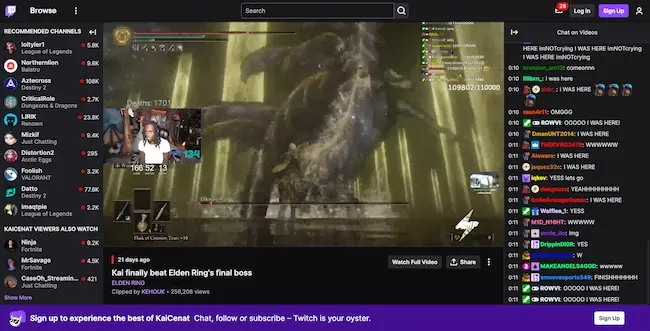
But of course, Twitch is not the best platform for every creator or content.
Where do content creators post their content?
Statistically speaking, Epidemic Sound found TikTok to be the top platform for generating income among creators, followed by YouTube. However, what platform works for you depends on your brand and audience.
Here are some of the most popular by creator type:
- Social Media Influencers: Instagram, YouTube, TikTok, LTK
- Podcasters: Apple Podcasts, Spotify, TuneIn, Google Podcasts, SoundCloud, YouTube
- Vloggers: YouTube, TikTok, Twitch
- Bloggers/Writers: Personal websites, Substack, Medium, Patreon
- UGC Creators: Instagram, TikTok, YouTube (but honestly, wherever the brand takes them)
Consider our gamer example again. Gamers typically share things like gameplay, reviews, and hacks. Knowing this, streaming on Twitch or posting videos to YouTube makes more sense than Instagram or a podcast.
On the other hand, a fashion blogger is probably turning to Instagram and an LTK page to enable their followers to shop most easily. Think creator Smita Patel.
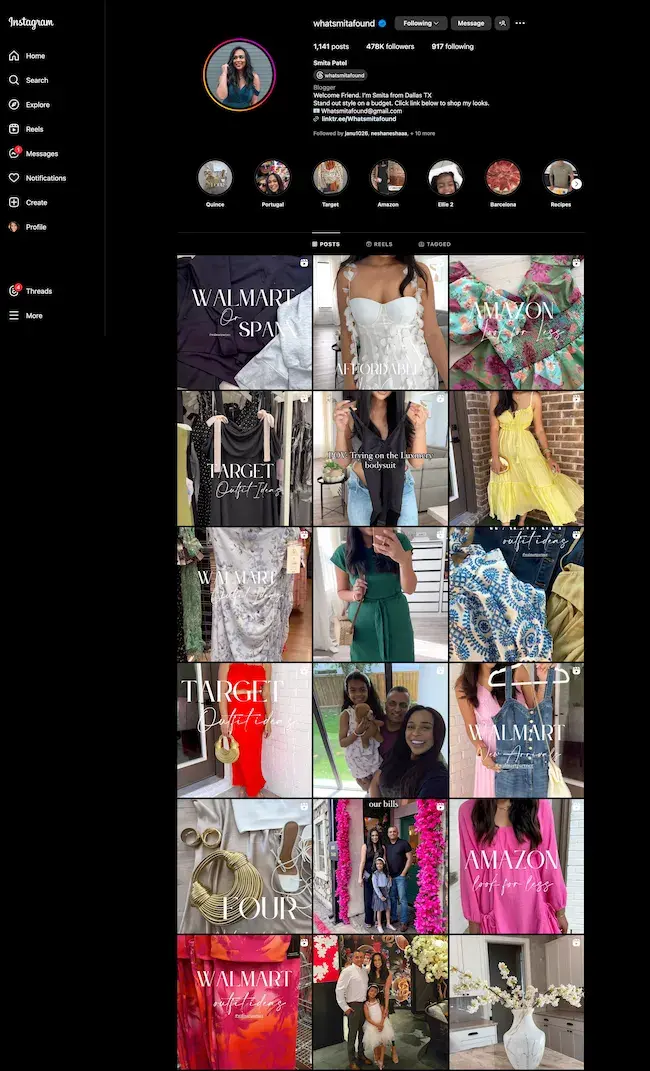
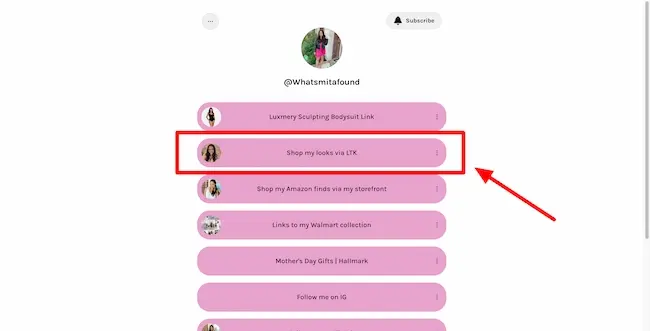
But that’s enough of the basics. Let’s get to the good stuff.
How to Become a Content Creator
Truth #2: Like all good things, becoming a skilled content creator will not happen overnight, and many people will never get there.
Being a content creator requires boundless dedication and, in an algorithm-driven world, sometimes a bit of luck. But with these steps, you’ll certainly put your best foot forward in achieving your goals.
Regardless of the specifics, there are some foundational steps to becoming a truly successful content creator. Here, I’ve broken the process down into eight steps.
1. Uncover your niche and audience.
If you’re considering becoming a content creator, you likely already have an idea of the topics you want to discuss or the audience you want to reach.
Maybe you have a background as a social media manager and want to share tips with small businesses and entrepreneurs. Or perhaps you paid off a ton of debt and want to share your personal finance tips with new college grads.
Creator Christine Buzan started her career in print media and marketing, assisting on fashion photoshoots. Today, she teaches nearly 800k followers on Instagram how to pose and look their best in photographs.
Whatever you choose to focus on will be your niche or positioning, and all the content you create should align. But don’t feel pressure to settle into a niche right away.
Content creator Vanessa Lau shares that you don’t necessarily need to have a niche as soon as you get started.
“If you are just starting out, I would say that experimenting with a broader niche and broader audience is going to help you accelerate the journey of finding that niche over time,” she shared on her YouTube channel.
“The mistake that I see a lot of aspiring content creators making is they stress so much about finding a niche to the point where they don’t create any content at all,” she said.
Translation: Put your ideas out into the world and see what hits and what doesn’t.
2. Develop your style and personal brand.
Ask yourself:
- How do you stand out?
- What makes your content different?
- How will it look and feel?
- What would make someone be able to recognize it even if it wasn’t on your platform?
Your brand is what makes your content unique and special. This could include the colors and fonts you use but also music, words, or taglines. It could also be your personal style of presenting information.
The creator who immediately comes to mind for me in this respect is Lilly Singh.
Lilly Singh first became a public name as YouTuber IISuperWomanII, sharing satirical skits and vlogs about growing up in a South Asian family.
But even as her career progressed beyond this niche — acting and producing films, authoring books, and being one of the first women ever to host a late-night talk show — her signature brand and humor remained.
The key to finding your style and personal brand like Lilly? Be yourself.
Content creator Erica Schneider has built a large following on X (formerly Twitter) by sharing writing and editing tips. These are common topics, but Schneider stands out by weaving her voice and personality into everything she shares.
She suggests creators show up as themselves too.
“Sounds simple, but it’s easy to lose your voice in a sea of templated tips,” she posted. “Let your personality out. Add your unique flare. Take a stance for or against something.”
Audiences may click on your content for the information, but they come back for the personality.
Pro Tip: Other creators’ styles can inspire you, but don’t copy them. Find something that genuinely resonates with your personality and let it shine through in your content.
And, remember, style can be anything. Don’t force humor or sarcasm just because “everyone else is doing it.” Do what you’re comfortable with, and you’ll find your audience quickly.
3. Determine your platform(s).
As we discussed earlier, there are dozens of platforms to post your content. But where will you find the most success?
When deciding which one(s) to focus on, consider three things: your niche, your audience, and your content format.
Niche
Some topics are more prevalent on particular platforms than others. Furthermore, some platforms are better suited to action (such as shopping) than others.
Consider your subject matter and the action someone would usually take after learning about it. Would they want to subscribe to know more? Would they want to buy something?
You’ll want where you post your content to make sense for what you’re talking about and your audience’s behavior.
Target Audience
Posting content is pointless if it’s not getting seen by the right people. You need to meet your target audience where they already are. Publish content where they hang out.
Say you’re targeting Gen Z. YouTube, Instagram, and TikTok are the social media platforms they frequent the most. Trying to reach baby boomers? Turn to Facebook. Corporate executives? Maybe your platform is LinkedIn.
Dig deep into the nuances of your target audience and buyer persona to determine where they are actively visiting. This is the fastest and easiest way to get in front of them and build a following.
Content Format
Make sure the platform you choose is optimized for your preferred content format.
For instance, if your topic calls for long-form videos, YouTube is likely your best option over TikTok, which has a maximum duration of 30 minutes.
If you share primarily static graphics, then YouTube would make no sense. Opt for Instagram.
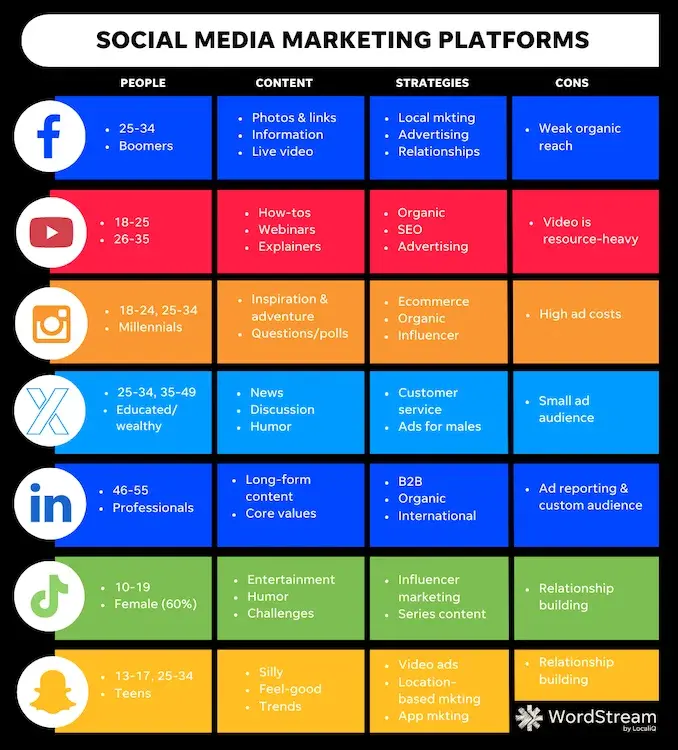
4. Create a content calendar.
Next, sit down and make a list of the content you plan to publish.
Success as a content creator depends on consistency. You must regularly share content related to your niche to grow and maintain your audience and relevance. So, plan ahead.
Create a content calendar for as far into the future as you can. I recommend mapping out at least two weeks and having your content ready a week before publishing so you aren’t left scrambling at the last minute.
HubSpot has a social media calendar template to help you get started.
5. Invest in any necessary tools.
For most content creators, a smartphone is the only thing they need to get started. But, if you have the means, some additional tools can give your content that little extra something.
Visual content may mean investing in graphic design software (i.e., Canva or Adobe Illustrator) or video editing tools (like CapCut). Maybe it’s a ring light or a studio backdrop.
For copy, perhaps, it’s a pro subscription to Grammarly or, for podcasts, audio editing software like Descript.
Take some to think through what might be beneficial and get your toolbox together.
6. Create!
Now for the fun part — actually creating your content.
You’ve been waiting for this, so enjoy and give it your all.
Perfection is the enemy of productivity. So don’t let it stop you from getting content published.
Bloopers and mistakes are human, and people love creators who are human. So don’t be afraid if you fumble your words or forget a point. These little things can actually make content more engaging.
Plus, the sooner you ship content, the sooner you can start analyzing what works and what doesn’t.
7. Track performance and refine.
Hitting “post” or “publish” doesn’t mean you’re done with your content. Now you need to track its performance and use that information to guide future creations.
What posts got the most views, comments, likes, and shares? What wasn’t as popular? These insights help you know what to lean into in the future.
If you’re a HubSpot user, our free Marketing Analytics tools makes tracking many of these social metrics easy.
8. Create a portfolio.
Creating for the sake of creating is great, but if you can get paid for it, that’s even better. So, this last step is all about money.
Influencer Marketing Hub says one in ten influencers makes upwards of $100k a year.
How do they do this? Well, some platforms like YouTube will pay you for creating content when you’ve built a large enough audience and engagement. But if you’re not at the level yet, you need to establish brand deals or collaborations.
A brand deal can come in many forms:
- Sponsored Post or Ad: A brand pays you or offers a free product in exchange for a post about their product on your platform.
- UGC: A brand pays you to create a piece of content for them to use on their platforms or in ads.
- Affiliation or Partnership: You talk about a brand or product and get a commission if someone buys through your referral link.
(For a deeper dive, check out our article “Affiliate Marketing for Beginners: What You Need to Know.”)
Regardless of the arrangement, a portfolio is often the first step in making it happen.
When one of your creations performs well, or you’re simply proud of it, document it in a portfolio.
Having a collection of your best work makes it easier to pitch brands you would like to work with or simply share what kind of content someone can expect.
Pro Tip: Need help building an online portfolio? HubSpot’s Content Hub is a great free solution.
Tips for Aspiring Content Creators
- Stay true to your brand/niche.
- Read content about your industry every day.
- Write on the regular.
- Study your audience.
- Curate other people’s content (when it makes sense to).
- Offer solutions, not just commentary.
- Understand your metrics and key performance indicators (KPIs).
- Network at every opportunity.
- Question everything.
Once you get going, remember these tips to start leveling up your game as a content creator.
1. Stay true to your brand/niche.
Once you find your brand/niche, stay true to it.
Creating content on a topic or product that is completely irrelevant to your audience or area of expertise is not only ineffective but confusing.
The content you share should be a natural fit. You should be able to speak confidently about the topic or product and with genuine passion.
Success as a content creator is all about trust and authenticity. People follow creators and influencers because they feel connected and believe they have their best interests in mind.
If something you post is off-brand or simply going in for a hard sell, your audience won’t buy it — literally and figuratively. So, be strategic about the content you post and the deals you accept.
Popular productivity expert Ali Abdaal has done a great job of staying true to his niche.
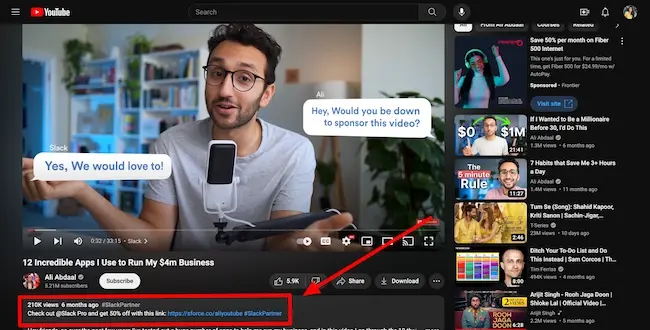
In this video, Abdaal shares 12 productivity tools, including messaging app Slack. As a Slack Partner, he includes an affiliate link in the video’s description, offering viewers a generous discount and earning him a commission.
Now, clearly, Adbaal benefits from talking about the tool. But because it is within his niche and gives his audience relevant value, that doesn’t matter.
2. Read content about your industry every day.
Creating great content that resonates with your target audience means staying current in your industry.
This sets them up nicely to understand what’s going on in the world and how that shapes their audience’s mindset. It also enables them to react quickly and get in on trending topics or memes to stay relevant.
The Marketing Millennials — a meme account beloved by myself and many of my teammates is a master of this. Take this post after the launch of Taylor Swift’s latest album, The Tortured Poet’s Department.
Subscribe to newsletters, listen to podcasts, set up alerts, and read industry publications and blogs.
Also, ask your audience what they’re reading and watching these days and follow suit. By discovering where your audience spends time online, you can learn even more about the topics and types of content they’re drawn to.
3. Write on the regular.
As content thought leader and author Ann Handley says, “Everybody writes.”
Successful content creators understand the importance of exercising their writing muscles, even if they’re not bloggers or writers by focus.
Doing so helps flesh out ideas and identify nuggets that could come to fruition later. It is also needed for creating video scripts, podcast notes, and snappy post captions.
Get in the habit of writing by doing it daily or every other day. I‘m not saying you need to write a polished, 1500-word essay on an industry-relevant topic daily. Rather, set aside 10 or 15 minutes to jot down some thoughts and ideas.
Content creator Zak Sherman shared his daily writing routine, demonstrating that you don’t need to write essays to practice writing. Even sending an email can be an exercise in crafting your words and finding your voice.
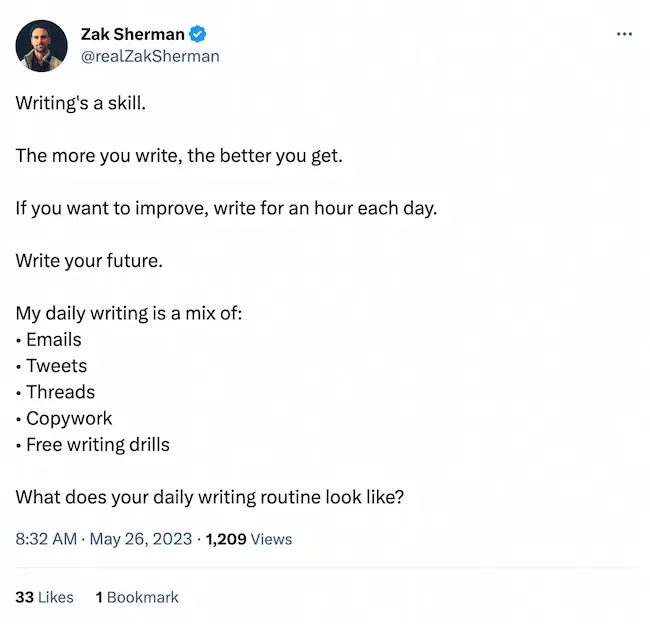
If you run into writer’s block (even the best of us do), leverage HubSpot’s Free AI Content Writer to get you going.
4. Study your audience.
Truth #3: Content creators are often at the mercy of their audience; sometimes, those needs and expectations can feel limiting.
But ultimately, your audience is why you have the platform and influence you do. You‘ll find new opportunities to help and create if you continuously listen to them.
One of the most important qualities of all successful content creators is that they know their audience inside and out. Keep a pulse on yours.
Tracking and analyzing specific metrics can help determine if your content resonates with your audience.
For instance, a high open rate tells you your subject line spoke to your subscribers if you have a newsletter. A high click-through rate lets you know that people wanted to know more about what you wrote about.
Look for key behaviors, interests, and trends and respond accordingly with your content.
If you’re still stuck, ask your audience directly. Tools like SurveyMonkey or even Instagram Polls and Question Stickers make it easy to reach an engaged audience.
The people who are genuinely invested in your content and brand will be more than happy to share feedback.
5. Curate other people’s content (when it makes sense to).
There’s no shortage of people curating content these days.
In fact, curation is built into most platforms in the form of “shares,” “retweets,” and “repost with your thoughts.”
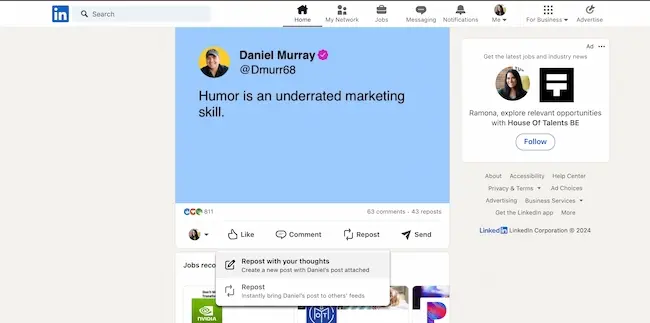
But successful content creators know it’s not enough to simply republish relevant news as is. Sharing how the information is relevant to you is key.
Freelance writer and content creator Kat Boogaard offers a weekly newsletter to subscribers who want her tips and insights on freelancing. One section of the newsletter is dedicated to other relevant resources.
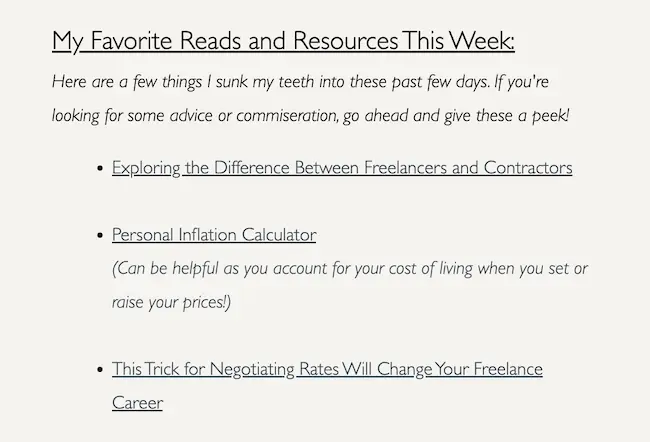
Get in the habit of curating content when you have something valuable to add.
Now that you’ve started scouring the internet regularly for industry news, you probably have a wider depth of knowledge than you think.
6. Offer solutions, not just commentary.
While sharing your thoughts is important, don’t stop there.
The people consuming your content aren’t interested in just hearing you talk — at least not all the time. They come looking to satisfy specific needs. Provide actionable tips and walk them through the solutions you’re suggesting.
This is a tip Stylist Nina Walder regularly implements in her content.
Here, you’ll notice she verbally tells viewers to “save and follow for more tips.” She also includes steps to access her free course in the caption.
This is similar to what content marketers do when publishing an article and ending with a call-to-action to a relevant offer. We give readers value through the article content and provide them with direction on what to do next with the offer.
7. Understand your metrics and key performance indicators (KPIs).
I can’t lie to you: I don’t like metrics. I often try to run from them, but they catch up to me as they’re crucial to reaching any goal. That includes becoming a successful content creator.
Publishing content doesn‘t mean you’ll automatically catapult to fame. Rather, your audience and impact will hopefully improve and grow slowly.
Tracking KPIs is how you monitor that growth is happening and ensure that it does. Let me explain.
A KPI is a specific metric you’ve chosen to measure how well your content is doing against your goals. For example, if I want to reach more people on YouTube, my KPI may be channel subscribers. To reach my goal, I would:
- See where my subscriber number sits currently.
- Set a number and a date by which I would like to reach it.
- Look at the subscriber number regularly (say weekly) to ensure my work is leading to that growth.
Some other KPIs that content creators might track include:
- Number of impressions or views
- Number of shares
- Number of comments
- Number of followers
- Click-through rate (if you have a link or call-to-action present)
Monitoring metrics can also help your plan and refine your content strategy.
8. Network at every opportunity.
Great content creators know they didn’t get where they are today alone. It’s also thanks to those who taught, inspired, and pushed them to think differently. They know that there is always more to learn and to be open to new ideas.
Networking forces you to do just that. It‘s a time to connect but also listen to outside points of view.
Never miss an opportunity to get in the room with fellow creators and learn from them. That means online (they aren’t called social networks for nothing) but also in person. Attend conferences, meet-ups, and workshops.
Have business cards or your QR codes handy to stay in touch. These connections can lead to learning and professional opportunities.
9. Question everything.
Great content creators are curious by nature; curious about their existing knowledge as well as the world around them. It’s these thoughts that lead to engaging content.
So, get in the habit of questioning the status quo.
Pro Tip: Don’t be afraid to play devil’s advocate. Taking a less popular view on a topic can be difficult at first, but it helps you stand out and attract an audience who will be interested in what else you have to say.
Critical thinkers make great content creators.
‘Create’ Your Own Destiny
Truth #4: Not everyone has what it takes to be a content creator.
But don’t let this scare you.
Becoming a content creator essentially means becoming an entrepreneur, and the scale of your success is in your hands.
It takes confidence to put yourself out there, but humility is needed to recognize that you have to put the work in to stand out from the competition.
It takes originality, authenticity, fierce dedication, keen strategy, and a great deal of self-management, resilience, and organization.
Just know that being a successful content creator starts with passion.
If you are passionate about your niche and audience and the value or message you have to share with the world, the steps outlined above will be a breeze.
And more than anything, you’ll be in a prime position to launch a well-thought-out and fruitful content creation career.
![Download Now: 150+ Content Creation Templates [Free Kit]](https://no-cache.hubspot.com/cta/default/53/5478fa12-4cc3-4140-ba96-bc103eeb873e.png)




